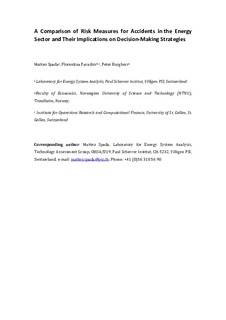| dc.description.abstract | Within the broader context of energy security and critical infrastructure protection, the comprehensive assessment of accidents and their related consequences are of high priority for many stakeholders. The risk of accidents is commonly assessed by aggregated risk indicators, allowing for a consistent and direct comparison between energy chains and country groups. However, these indicators do not explicitly evaluate consequences at selected probability levels and/or consider risk aversion aspects. Furthermore, in risk-informed decision-making it is important to account for risk preferences of different stakeholders. To overcome these potential drawbacks, in this study, Value-at-Risk, Expected Shortfall and the Spectral Risk Measures, which are commonly used in the financial realm, are applied within an energy security perspective. In particular, fatality risk indicators are calculated for different country groups of three fossil data sets (coal, oil, natural gas) extracted from the Energy-related Severe Accident Database (ENSAD). The use of these risk measures facilitates a direct comparison and a better understanding of energy accident risks to insurers and other industry stakeholders that normally focus on financial and less infrastructure-related aspects. Furthermore, the usefulness of the risk measures and their pros and cons in the evaluation of accident risks in the energy sector has been discussed. | nb_NO |
